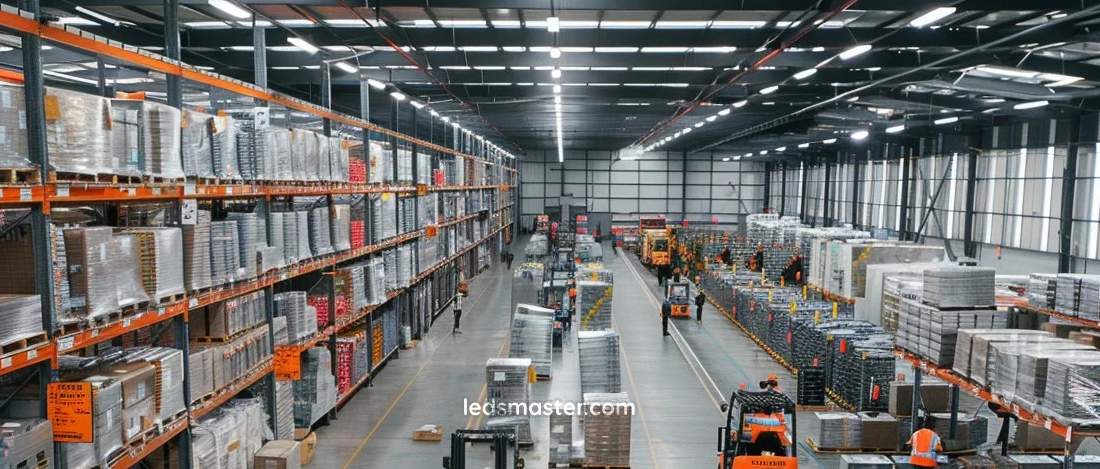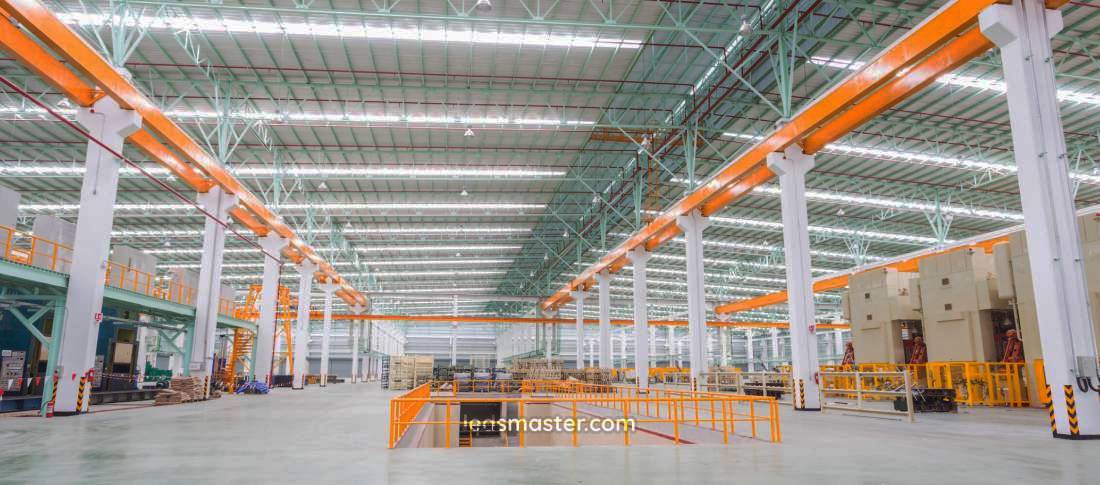It’s more than just illumination; it’s about creating a safe, efficient workspace that supports productivity and easy navigation. This article highlights how smart lighting solutions can transform a warehouse into a well-lit, high-functioning operation.
Warehouses are pivotal spaces in logistics and storage operations, requiring precise lighting solutions to ensure safety, productivity, and operational efficiency. From optimizing visibility for inventory management to enhancing worker safety, the choice of lighting in warehouses significantly impacts overall functionality and cost-effectiveness.
Get your complimentary lighting design today
Table of Contents
ToggleUniformity in warehouse lighting refers to the even distribution of light across the entire space. Achieving uniformity is vital for minimizing shadows and glare, which can impede visibility and safety. High uniformity ensures consistent lighting levels throughout the warehouse, reducing eye strain and enhancing operational efficiency. By providing a well-lit environment, workers can perform their tasks with greater accuracy and confidence.
LED lighting fixtures are often preferred for their ability to provide superior uniformity compared to traditional lighting technologies. Unlike fluorescent or incandescent lights, LEDs distribute light more evenly, ensuring that every corner of the warehouse is adequately illuminated. This characteristic is particularly beneficial in large spaces where uneven lighting can lead to productivity issues. With a variety of designs and configurations available, warehouse managers can select LED fixtures tailored to their specific operational needs.

To maximize the effectiveness of lighting fixtures, it is essential to evaluate the specific needs of the warehouse. Factors such as ceiling height, shelf arrangements, and the nature of tasks performed in different areas all play a role in determining the most suitable lighting solutions. Conducting a thorough assessment allows for more informed decisions regarding fixture types and placements.
Regularly measuring illuminance in various sections of the warehouse can provide valuable insights into lighting performance. Using tools like light meters, managers can assess whether the current lux levels meet operational requirements. This ongoing evaluation can inform adjustments in lighting plans, such as adding fixtures or repositioning existing ones, to optimize brightness across different areas.
Lux levels, a measure of illuminance, dictate the brightness required within different areas of a warehouse. The appropriate lux levels vary based on tasks performed in each zone. For example, picking areas may require higher lux levels (500-1000 lux) to facilitate accurate reading of labels and codes, while storage areas may suffice with lower lux levels (150-300 lux). This variation reflects the different operational demands placed on workers, highlighting the need for careful consideration in lighting design.
LED high bay fixtures are commonly used to achieve these lux requirements efficiently. These fixtures offer directional lighting that reduces wasted light and energy costs, making them an ideal choice for warehouses. By directing light where it is needed most, LED high bays contribute to improved visibility and reduced energy consumption. This targeted approach not only enhances productivity but also supports sustainable practices by lowering overall energy usage.
It is also important to consider the specific tasks performed in different areas of the warehouse when determining lux levels. For instance, quality control stations may require even higher lux levels to ensure that workers can accurately inspect products. By tailoring lighting to specific tasks, warehouse managers can further enhance operational efficiency and safety.
Adhering to local and national lighting regulations is also essential in determining lux levels. Various organizations, such as OSHA and ANSI, set standards for workplace illumination that help ensure safety and efficiency. Understanding and complying with these guidelines helps create a safer working environment while protecting the organization from potential liabilities.
Color temperature plays a significant role in creating a productive and comfortable warehouse environment. Measured in Kelvin (K), it determines the warmth or coolness of the light emitted by a fixture. Warehouses typically benefit from cooler color temperatures (5000-6500K) as they mimic natural daylight, enhancing alertness and visibility. These cooler tones can positively influence workers’ moods, making them feel more engaged and focused on their tasks.
In contrast, warm color temperatures (3000-4000K) may be suitable for less active areas where a more relaxed ambiance is desired. These warmer tones create a comfortable environment, reducing the harshness that can be associated with brighter lights. In areas such as break rooms or lounges, a softer light can promote relaxation, ensuring that employees have a comfortable space to recharge.

LED lighting’s tunable color temperature options provide flexibility to adjust lighting based on specific operational needs. With the ability to customize the light spectrum throughout different times of the day, warehouse managers can adapt the environment to enhance productivity and worker satisfaction. This adaptability can be particularly useful during peak operation hours, where cooler light can help maintain focus, while warmer light can be used during less demanding times.
Research has shown that different colors of light can influence mood and productivity levels. Cool white light, for example, is associated with alertness and focus, while warm light is often linked to comfort and relaxation. Understanding these associations allows warehouse managers to strategically utilize color temperature to create an environment that maximizes worker productivity and satisfaction.
Energy efficiency is a primary consideration in warehouse operations, where lighting can account for a substantial portion of energy consumption. LED lighting solutions offer significant energy savings compared to traditional HID (high-intensity discharge) or fluorescent lighting. LEDs consume less energy while producing higher-quality light, resulting in lower utility bills and reduced maintenance costs.
Additionally, LED fixtures have longer lifespans, minimizing replacement and downtime expenses, thus contributing to overall operational cost savings. This longevity means that warehouses can reduce their frequency of maintenance and replacement, allowing for more efficient use of resources. As a result, transitioning to LED lighting not only saves money but also streamlines operations by reducing the time and effort spent on lighting upkeep.
When considering lighting upgrades, it is advisable to conduct a cost-benefit analysis. This analysis should factor in the initial investment, potential energy savings, and the expected lifespan of the lighting fixtures. By doing so, warehouse managers can make informed decisions that align with their budgetary constraints while achieving optimal lighting conditions.
In addition to upgrading to energy-efficient lighting, it is beneficial to conduct regular energy audits. These audits can help identify areas where energy is being wasted, such as unused spaces that remain illuminated. By addressing these inefficiencies, warehouses can further optimize their energy usage and enhance overall operational sustainability.
Warehouses often operate in demanding environments with dust, humidity, and varying temperatures. Lighting fixtures must be durable and resilient to withstand these conditions without compromising performance. LED fixtures are inherently rugged, with robust construction and sealed designs that protect against dust ingress and moisture. This durability ensures that the lighting system remains functional and effective, even in challenging conditions.
Furthermore, LEDs are resistant to vibrations and shocks, making them ideal for industrial applications where reliability is vital. The resilience of these fixtures can lead to fewer failures and disruptions in the workplace. By maintaining consistent lighting conditions, warehouse operations can run smoothly, minimizing the risks associated with unexpected outages.
When selecting lighting fixtures, it is important to consider the specific environmental challenges of the warehouse. For instance, areas with high humidity or temperature fluctuations may require specialized fixtures designed to handle such conditions. Ensuring that the selected lighting can withstand the unique demands of the environment contributes to long-term reliability.
Before installation, it may be prudent to test lighting fixtures in the actual warehouse environment. This testing can help identify any potential issues related to durability and performance. By evaluating how fixtures respond to environmental factors, managers can make better-informed decisions regarding the best products for their specific needs.
Smart lighting systems offer advanced functionalities that optimize warehouse lighting control and energy management. These systems incorporate sensors, dimming capabilities, and automated scheduling to adjust lighting based on occupancy and daylight levels. For instance, motion sensors can detect activity in specific areas, automatically adjusting light levels or turning off fixtures in unoccupied zones to further conserve energy.
This technology enhances operational efficiency by ensuring that energy is only used when needed. By automating the lighting system, warehouses can reduce their energy footprint while maintaining optimal working conditions. Additionally, these smart solutions can be integrated into broader building management systems, providing comprehensive control over various environmental factors.
With the advent of smart technologies, warehouses can now utilize data analytics to inform lighting decisions. By collecting data on occupancy patterns and energy usage, managers can refine their lighting strategies to achieve even greater efficiencies. This data-driven approach ensures that lighting is both responsive and adaptable to the evolving needs of the warehouse.
Installing warehouse lighting requires careful planning to ensure optimal placement and coverage. High bay LED fixtures are commonly used for their ability to provide ample light from elevated positions, maximizing floor space utilization. Proper installation minimizes dark spots and ensures uniform light distribution across aisles and storage racks.
Effective placement of lighting fixtures can dramatically improve the overall functionality of the warehouse. Thoughtful design considerations, such as the height of fixtures and their distribution, can prevent common issues like glare and uneven lighting. Addressing these factors during the installation process can lead to a more productive and safe working environment.
Routine maintenance, such as cleaning fixtures and inspecting for any signs of wear, helps prolong the lifespan of lighting systems and ensures consistent performance over time. Regular maintenance is crucial in preserving the quality of lighting, as dirt and dust can accumulate on fixtures, diminishing their effectiveness. By establishing a routine maintenance schedule, warehouse managers can ensure that their lighting systems operate at peak efficiency.
Additionally, training staff to recognize the signs of lighting issues can contribute to proactive maintenance efforts. Employees who are aware of the importance of lighting quality can report problems early, allowing for timely interventions that prevent larger issues from arising. This proactive approach fosters a culture of responsibility and attentiveness, ultimately benefiting the entire operation.
Selecting the right lighting solutions is vital for maximizing efficiency and safety in warehouse environments. LED technology emerges as the preferred choice due to its superior energy efficiency, durability, and flexibility in providing optimal light levels and color temperatures. Understanding the importance of uniformity, lux levels, and smart control systems empowers warehouse managers to make informed decisions that enhance operational productivity while contributing to long-term cost savings and sustainability efforts.